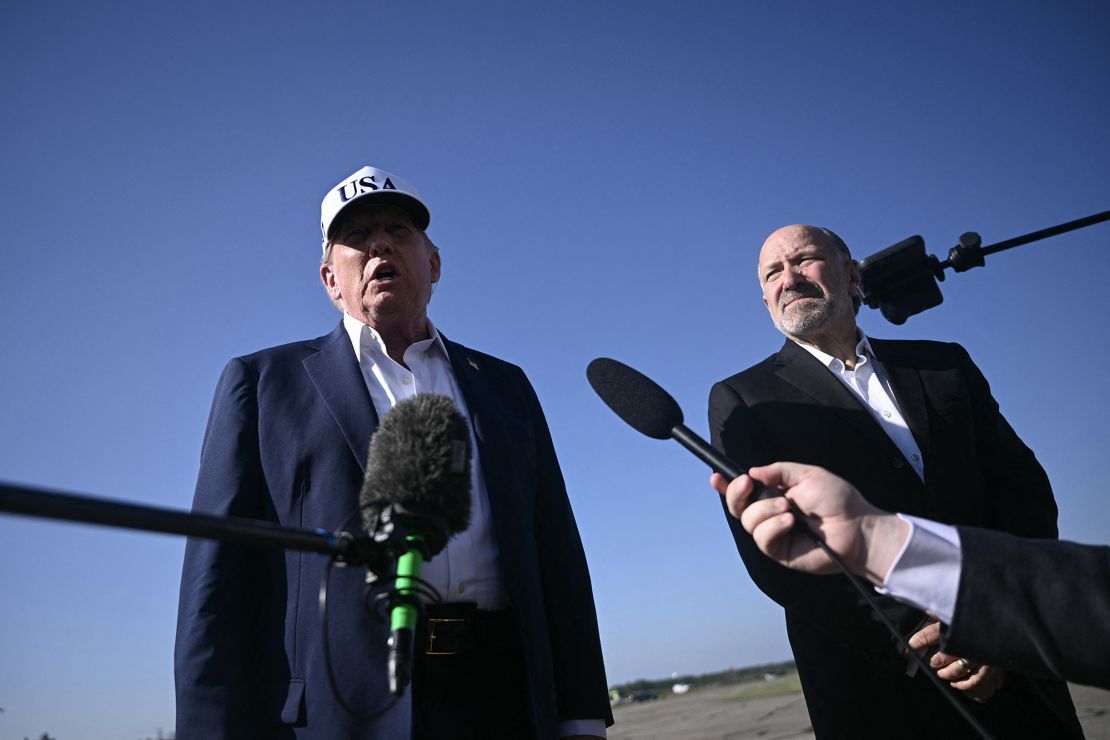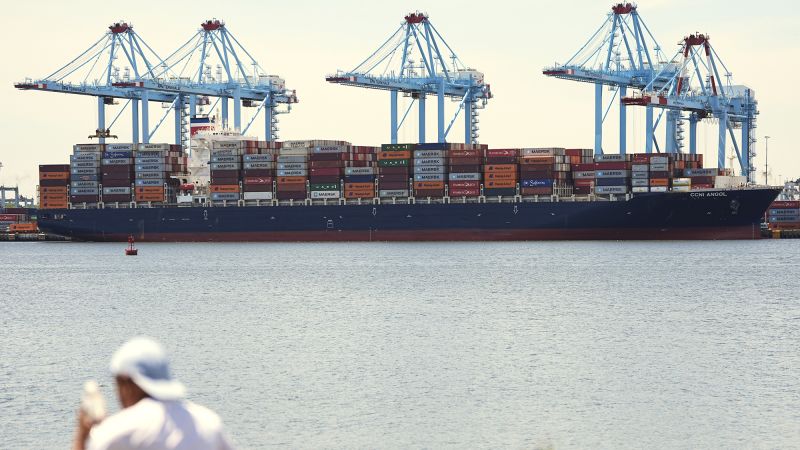CNN
—
Three months later, President Donald Trump’s endgame for his once market-rattling tariffs was supposed to arrive tonight at midnight.
But it won’t.
As the clock rapidly ticked toward the long-standing July 9 end of Trump’s 90-day pause on soaring “reciprocal” tariff rates on more than 60 countries, Trump on Monday signed an executive action extending that reprieve until August 1.
Despite significant progress with several trading partners, including India, Brazil, the European Union and several Asian countries, according to US officials, the global financial system has started to grapple with the reality that the deals, the details and even the deadline sit in a state of limbo.
Trump’s top trade and economic advisors insisted, as they have for the better part of the last two months, that deals will be announced in rapid succession this week. They also spent Sunday telling the world tariff rates wouldn’t snap back into place until August 1, in an implicit hedge if those deal predictions once again proved hollow.
It has been a whirlwind since then: Trump then announced on social media late Sunday night that he’d begin sending letters outlining the tariff rates or terms of bilateral agreements to trading partners. Then he announced a 25% tariff on Japan and South Korea and higher tariffs on a number of smaller trading partners Monday, with more letters expected to come in the days ahead.
He also launched a new tariff threat at the 10-nation bloc known as BRICS, which he’s long viewed as a direct and acute threat to US dominance in the global financial system. Trump didn’t mention that several BRICS countries are top US trade partners and currently engaged in intensive bilateral trade talks with Trump’s lead negotiators.
The actual deadline – whether August 1 or some future date Trump announces on social media – is a lot like the months-long bilateral talks launched in early April: fuzzy on actual details, light on actual outcomes, ambiguous on actual goals, all while projecting unflinchingly bold predictions of success.
All of it, most critically, contingent on the whims of the current inhabitant of the Oval Office.
“When you think about it, it’s kind of the perfect window into the whole second term approach,” a trade lawyer who worked in Trump’s first term told CNN. “Everything revolves around the president, and you can safely assume he rather enjoys everything that entails.”
Trump has spent the last 80-plus days fielding a steady stream of offers with concessions on market access for US products, reduced tariff rates, delayed tax and regulatory enforcement for US-based companies and a veritable potpourri of offers on unrelated policy matters thought to be important to his domestic agenda, according to multiple people involved in the process.
Trump views the deadline – or deadlines – as the most critical leverage to squeeze trading partners for a few more concessions or to drop their own red lines in the ongoing bilateral talks, officials said.
In other words, the pervasive uncertainty and ambiguity are kind of the point.
“I think what President Trump is concerned about is the quality of the deals, not the quantity,” Treasury Secretary Scott Bessent said Monday on CNBC.

The US economy has held up and overcome the dire predictions of catastrophe that sent the stock and bond markets into a sustained period of tumult through the spring. Wall Street has settled into a general state of Zen about Trump’s actual tariff intentions after a series of pauses and de-escalations.
The general exhaustion consuming investors after months on a hair trigger isn’t an insignificant factor driving that view, according to several market participants, who nonetheless expressed little anxiety about the optimism that has driven stocks to record highs.
Trump just signed the cornerstone of his legislative agenda into law, a major win.
At the same time, the US has collected $81.5 billion in tariff revenue through June, according to the US Customs and Border Protection, only serving to bolster Trump’s position, officials say.
“In his mind, he’s in a no-lose situation,” the former official said. “He’s going to keep amping up the pressure.”
That’s the backdrop to keep in mind throughout the critical week ahead.
The Trump administration has announced two bilateral agreements and a third with China that is better described as a de-escalation than a deal. That’s not to dismiss the China détente, as the de facto trade embargo between the world’s two largest economies that existed in April carried with it the potential to fracture the backbone of global commerce.
Trump has inked a trade framework with the UK (which wasn’t actually subject to the stratospheric “reciprocal” rates announced on April 2 in the Rose Garden). The granular details of that agreement are still in process, officials said.
Trump announced on social media last week that he’d signed off on a deal with Vietnam, which was facing a catastrophic 46% “reciprocal” rate at the end of the 90-day pause. The agreement would implement a 20% tariff on the country and a more draconian penalty on goods deemed by the US to be of Chinese origin but passed through Vietnam to avoid harsher tariffs.
The details remain opaque on how exactly that would be applied – or defined – and Vietnamese officials have been more cautious about declaring the agreement final.
We got our first glimpse Monday of Trump’s regularly promised trade letters, with missives sent to the leaders of South Korea, Japan, South Africa, Malaysia and several others that the president posted to Truth Social. He decried America’s imbalance of trade with those countries, as well as tariffs and other non-tariff barriers they place on US goods. Trump said the door was open to negotiation, but he threatened the countries with higher tariffs if they retaliate.
Is this how trade talks actually work? Not normally.
Bessent during his CNBC interview described the contents like this: “Thank you for wanting to trade with the United States of America. We welcome you as a trading partner, and here’s the rate unless you want to come back and try to negotiate.”
The administration is not seeking or planning to secure “trade deals” in the historical sense.
Those pacts, which take years to negotiate and even longer to implement, have never really been the goal.
Instead, the White House is seeking frameworks with a heavy focus on market access for US industries and products, while at the same time including commitments to reduce or remove entirely regulatory and legislative barriers to US exports.
So where do the crush of bilateral talks actually stand?
India has long been viewed as the most likely major partner to sign onto a framework with the US and may still do so this week, though Indian officials have hardened their positions in recent days, according to US officials. India is also a member of the BRICS group, so it’s unclear what Trump’s tariff threat Sunday means for trade negotiations.
South Korea had also been viewed for weeks as likely to reach an agreement, though Trump’s auto tariffs remain a key sticking point in those talks, and Trump’s letter Monday may have thrown a wrench in those gears.
Japan steadily moved further away from an outcome in recent weeks, and Trump cast significant doubt on talks that once seemed on a path to a certain agreement. Japanese officials, who just weeks ago were scrambling to lay the groundwork for an announcement by last month’s Group of Seven summit, have delivered far more pessimistic messages in their public statements in recent days.
EU officials have signaled more optimism in the last few days about clinching a framework with Trump’s trade negotiators after an intensive series of meetings and technical discussions in the last two weeks.
Indonesia, Cambodia and Thailand have all delivered substantial offers to their US counterparts in the last 10 days in an effort to move to the front of the line for an agreement and are likely candidates for any near-term deal in the next few days, officials said.
Brazil has ramped up its efforts to secure an agreement, including bilateral talks at the end of last week designed to expand on an earlier offer to sharply reduce tariffs on certain US products, officials said.
The most prevalent point of contention among foreign trade teams has been a lack of clarity on what their US counterparts envision for any final agreement.
But the most biggest roadblock in the more expansive negotiations has been the existence – or promised imposition – of Trump’s sectoral tariffs on autos, steel and pharmaceuticals, officials said.

